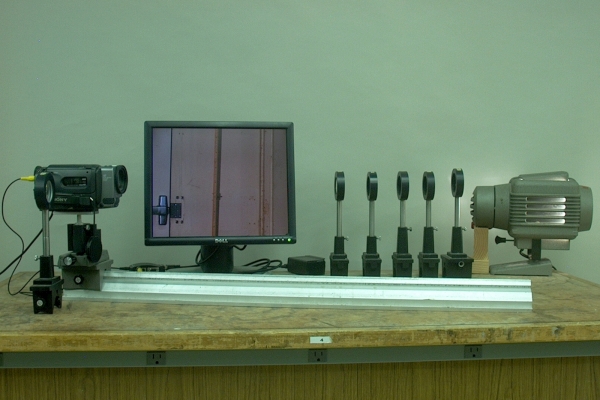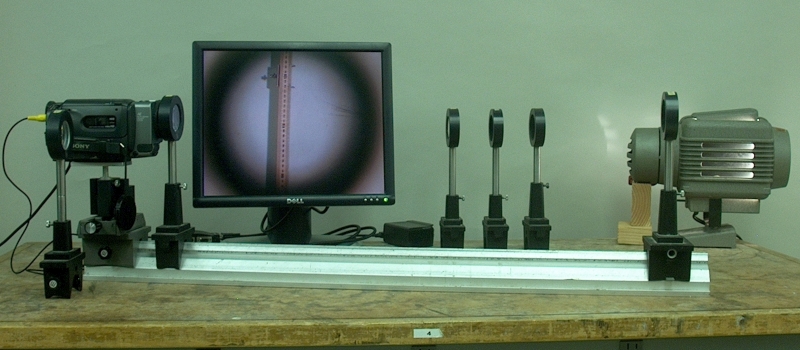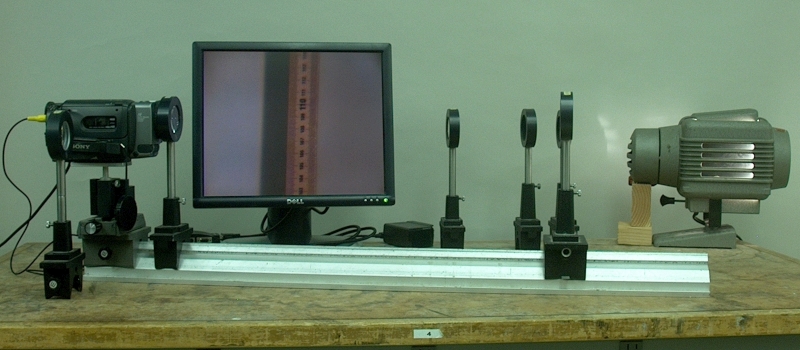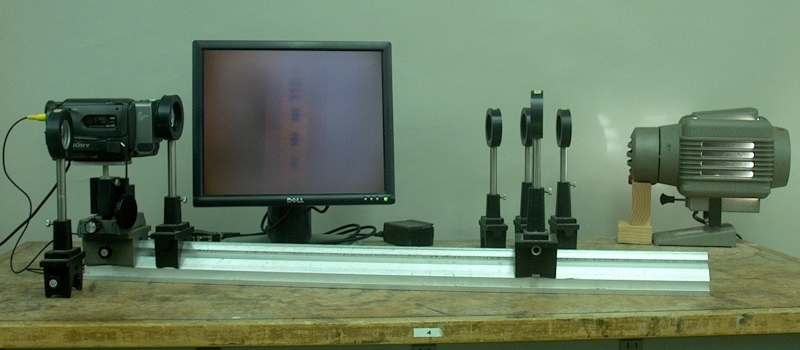

The camera mounted on the optical rail is aimed at a 2-meter stick approximately 6.5 meters away. At right, behind the rail, are five lenses, whose focal lengths are 50 mm, 100 mm, 200 mm, 250 mm and 500 mm. At left, next to the camera, is a lens whose focal length is -50 mm. At right is a spot light, which allows you to illuminate the 2-meter stick. (This is usually placed on the floor, but is set on the table for the photograph.) The display, shown facing front for purposes of photography, normally faces the rear so that you can see the image as you manipulate the apparatus. A tee on the camera output allows for connection to the projector in the lecture hall. There are several ways you can perform this demonstration. Originally, the apparatus was shown with a 200-mm objective in combination with a 100-mm ocular and a 50-mm ocular, for magnifications of 2 and 4, respectively. The camera zoom was set to yield an acceptable image with the 100-mm ocular. With the combinations afforded by the assortment of lenses above, you can obtain magnification as great as 10. Zooming the camera barely to accommodate a 250-mm ocular (which results in the image shown above), you can obtain magnifications of 2, 5 and 10, as shown below:

A 250-mm ocular and a 500-mm objective give a magnification of two.

A 100-mm ocular and a 500-mm objective give a magnification of five.

A 50-mm ocular and a 500-mm objective give a magnification of ten.
The lens arrangements above are examples of a type of refracting telescope, often called a Keplerian telescope, which consists of two lenses, both positive, the one with the longer focal length acting as the objective, and the other as the eyepiece, or ocular. As with demonstration 80.48 – Microscope, the apparatus above is a thin lens version of the system; in most telescopes, the lenses consist of multiple elements. A telescope allows us to view fairly large objects at great distances. In astronomical viewing, they allow us to look at obects that range in size from planets to galaxies, over vast distances. In a telescope, parallel rays enter the objective lens and focus on the opposite side of the lens, at its focal distance, fobj, where they form a real, inverted image whose height we will call h′. The eyepiece is set so that its focal point coincides with that of the objective. The image formed by the objective thus acts as an object for the eyepiece, which takes the rays diverging from the common focal point and transmits them on the other side as parallel rays, to form a virtual, inverted, image at inifinity. If we consider the parallel rays entering the telescope at some small angle, θobj, and the angle with which the rays forming the image leave the eyepiece θeye, the angular magnification, mθ, of the telescope is the ratio of these two angles, θeye/θobj. For paraxial rays (small angles), θobj = -h′/fobj, θeye = h′/feye (you may sometimes see the minus sign on the other term), and mθ = -fobj/feye, the ratio of the focal length of the objective to that of the ocular. We can see this from the photographs above, in which the size of the image on the screen is greater than that produced by the camera alone, by a factor of the ratio of the focal length of the objective to that of the eyepiece, and the image is inverted (hence the minus sign). That the image is inverted is made obvious by the clamp holding the two-meter stick, which appears in the top photograph with the screw at right and hooks at left, but reversed in the next photograph. As we can see, the length of the telescope is the sum of the two focal lengths, feye and fobj.
For astronomical viewing, it does not matter that the image is inverted. For terrestrial viewing, however, this might present a problem. One way to solve it is to insert an erecting lens between the objective and the ocular, but this results in an even longer instrument. Another way is to use a negative lens for the ocular, as in a Galilean telescope. Because the eyepiece has a negative focal length, it must be placed so that, instead of the common focal point sitting between the objective and the eyepiece, it now sits outside the eyepiece. The length of the telescope is still the sum of the focal lengths, but since one is now negative, it is shorter than if both lenses were positive lenses. The magnification is still mθ = -fobj/feye, but because feye is negative, mθ is positive, and the image is erect. The advantages of this arrangement are an erect image and a shorter telescope. A disadvantage is that to have a field of view comparable to that of the Keplerian configuration, you need an objective of significantly larger diameter.
The -50-mm lens shown above allows you to demonstrate the operation of a Galilean telescope if you wish:
A -50-mm ocular and a 500-mm objective give a magnification of ten, and the image is erect.
Note that the distance between the eyepiece and the objective is 100 mm smaller than for the 50-mm ocular with the 500-mm objective.
In the close-up at left above, for the 50-mm ocular and 500-mm objective, we see that the numbers ascend from the bottom of the screen to the top, and their tops are toward the left. In the close-up at right, for the -50-mm ocular and 500-mm objective, the numbers ascend from the top of the screen to the bottom, and their tops face right. Zooming the camera to give a similar field of view to what is shown at left makes this easier to see:
The outer diameter of the objective lens defines the entrance aperture of the system, or the entrance pupil. The telescope forms an image of the exit pupil at a small distance outside the ocular. The area over which this image appears is called the exit pupil, and the distance from the ocular at which it forms is called the eye relief. How large this distance is depends on the design of the ocular. For an ocular that has a negative focal length, the exit pupil actually lies between the ocular and objective, and the pupil of the eye acts as the exit aperture and thus the exit pupil.
The parallel rays coming through the exit pupil are also called the emergent pencil. The diameter of the emergent pencil is smaller than the diameter of the objective by the ratio of the focal lengths of the eyepiece and the objective, or the magnification of the telescope. That is, if we call the diameter of the emergent pencil d, d = dobj (feye/fobj) = -dobj/mθ. (The magnification is negative; see above.) In addition to their use to view distant objects, similar lens systems are used as beam reducers or expanders in optical systems.
Telescopes typically have a fixed objective lens of a single focal length, and one changes oculars to vary the magnification and angle of view. For most telescopes, the focal length of the ocular relative to that of the objective is considerably smaller than for the lens combinations available in this demonstration. This may put a constraint on the zoom setting for the camera. Ideally, it is preferable to set the camera so that its angle of view is similar to that of the human eye. You may, however, have to use a narrower zoom to obtain a reasonable image with the ocular of the longest focal length. In all cases, the camera focus should be set at inifinity.
References:
1) Halliday, David and Resnick, Robert. Physics, Part Two, Third Edition (New York: John Wiley and Sons, Inc., 1978), pp. 981-983.
2) Jenkins, Francis A. and White, Harvey E. Fundamentals of Optics, Second Edition (New York: McGraw-Hill Book Company, Inc, 1950), pp. 166-172.